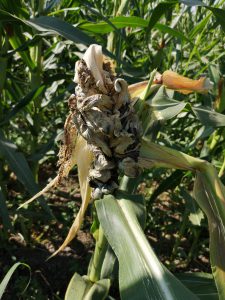Agent
Ustiloga maydis(-U.zeae)
Diseases can kill seedlings early. In the following year, fungus passes through the soil with contaminants and diseased plant residues. Wind is an important factor in the spread of fungus spores. The rains in the summer can encourage the disease. Irrigation can encourage disease in arid regions. Maydis leads to the formation of galls in the leaves, stems, cobs, tassels and male flowers from the above-ground organs of the plant. As the galls mature, the membrane turns yellow and cracks form on it.
Disease Cycle and Epilemiology
Fungus spends the winter in teliospor in the soil and can maintain its vitality for many years.
Teliospores germinate either directly or indirectly in a humid environment in a wide temperature range of 10-35C. Direct germination occurs with an infection hypha produced directly from a germinating teliospor. This process is carried out by a promiseum.
Arid conditions and 26-34C temperature, which delay the development of the plant, are suitable factors for disease development. Abnormally cool, moist air, which delays the growth of young corn plants, accelerates the development of the disease.

Fighting
Crop rotation should be applied for at least 3-4 years,
Sowing should not be done too early or too late,
The galls must be cut and thrown while the process of formation,
The galls should either be buried deep or burned,
Plants should not be scarred,
Excess nitrogen fertilizer should not be given and balanced fertilization should be applied,
Pests should be dealt with in a timely manner,
Resistant species should be grown,
Fusarium Stem Rot
Symptoms
Fusarium grain rot is not seen in the whole of the plant’s cob. Symptoms occur in grains at the ends of the cobs and are dispersed. Especially in places where insect damage occurs, the disease is intense. The color of infected grains varies from pink to red brown. As the disease progresses, a dusty and cottony mold develops on the grains.
Grains without symptoms; it can be as poisonous as plant parts that are clearly colonized by cracked grains and fungi.
Seedlings grown from inoculated grains prevented the growth of shoot diameter, plant height, leaf length and plant weight 7 days after planting.
Disease Cycle and Epilemiology
Fungus survives as chlamidospor-like structures as hypha thickened in plant residues or grains. However, the pathogen cannot survive in the soil for a long time.
Infection in grains can occur in 4 ways:
Airborne cones can infect the damaged vessel due to cracks by air and other means like insects such as corn cobworm, maizeworm.
Spores germinate and myceliums formed infect by reaching the lower grains from the tassels at the ends of the cobs.
Infection may occur with colonization from the stalk that fungal development continues.
Infection can occur in an infected plant without symptoms. Seed-borne fungus strains can develop to systemically infect grains in an endophytic relationship.

Dry, warm air is generally suitable for disease development. When harvesting is delayed beyond physiological maturity, the presence of F. Verticillioides may increase. This fungus cannot improve in grains with a moisture content of 18-20%. Unless suitable moisture and temperature conditions exist in the grain, generally, fumonis (a class of mycotoxins with a carcinogenic effect) cannot be considered to increase during storage.
Fighting
Using sensitive species against the disease should be avoided,
Grains should be harvested early to prevent weather deterioration,
Corn cobs should be dried to a humidity of 15% or less,
Should use sweet corn hybrids that are resistant.

